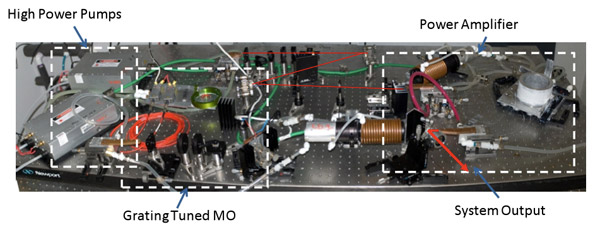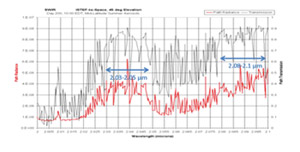Thulium doped silica fiber has a large spectral emission bandwidth ranging from <1.9 μm to >2.1 μm. This spectral region is of interest as it falls into the “eye-safe” regime and concurrently in atmospheric propagation windows, thus enabling its use for applications in ranging, sensing and directed energy. There are two atmospheric transmission windows in the thulium emission range which can be used as seen in the figure below.
Testing of propagation through these atmospheric windows must be conducted in order to determine their usefulness and to better understand atmospheric effects on laser beams at 2 μm wavelengths over propagation distances of multiple kilometers. The goal of this project is to develop a laser system for making these long distance atmospheric measurements. The atmospheric testing puts numerous requirements on laser performance:
- High beam quality
- Compact and portable
- Narrow, widely tunable laser linewidth
- Up to 200 W power to enable long distance transmission with stable output over time
The system includes a diffraction grating tunable single mode fiber based Master Oscillator with:
- Maximum output power is 10 W
- High Degree of polarization with stable PER of >20 dB
- ~200 nm tuning range from 1900 nm to 2100 nm with <150 pm linewidth
And a LMA Power Amplifier seeded through an optical isolator
- Capable of 200+ W operation from 1927 nm to 2095 nm, <150 pm linewidth
- Slope efficiency as high as 63% due to efficient cross relaxation in thulium
- Stable operation over entire range for >1 hour
- High beam quality M2 < 1.2 at full power
The laser system fits on 6’x2’ breadboard and is completely portable and is in the process of being deployed to ISTEF facility for atmospheric propagation experiments and is being converted to a user facility level system.


